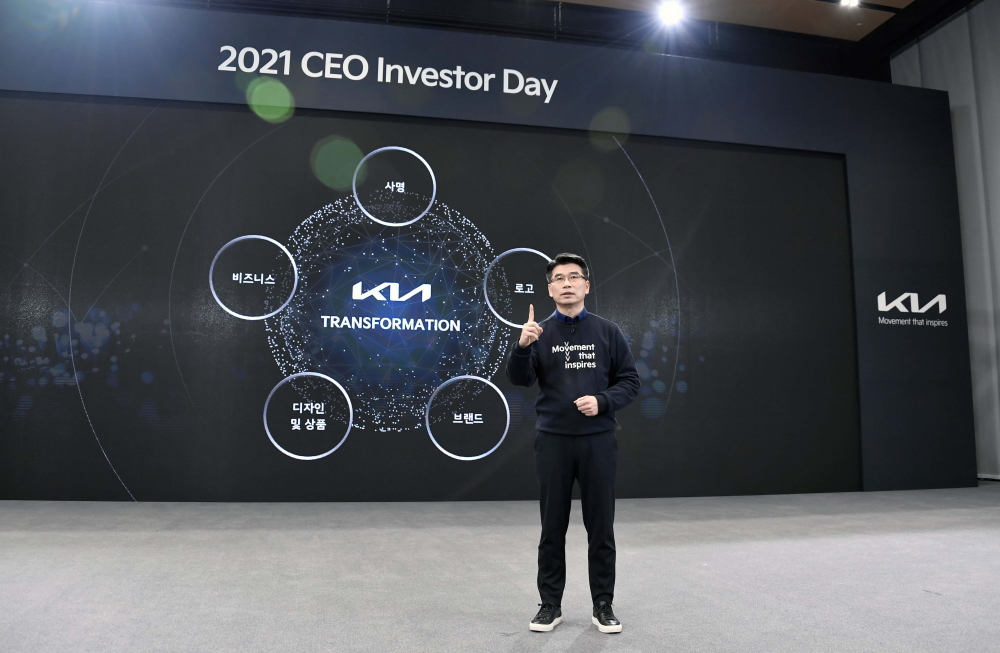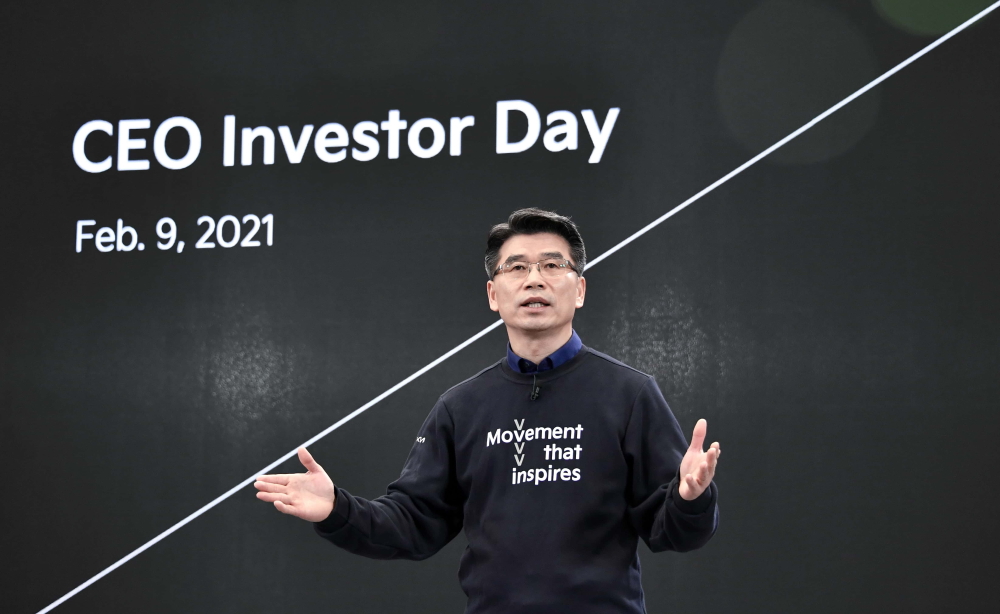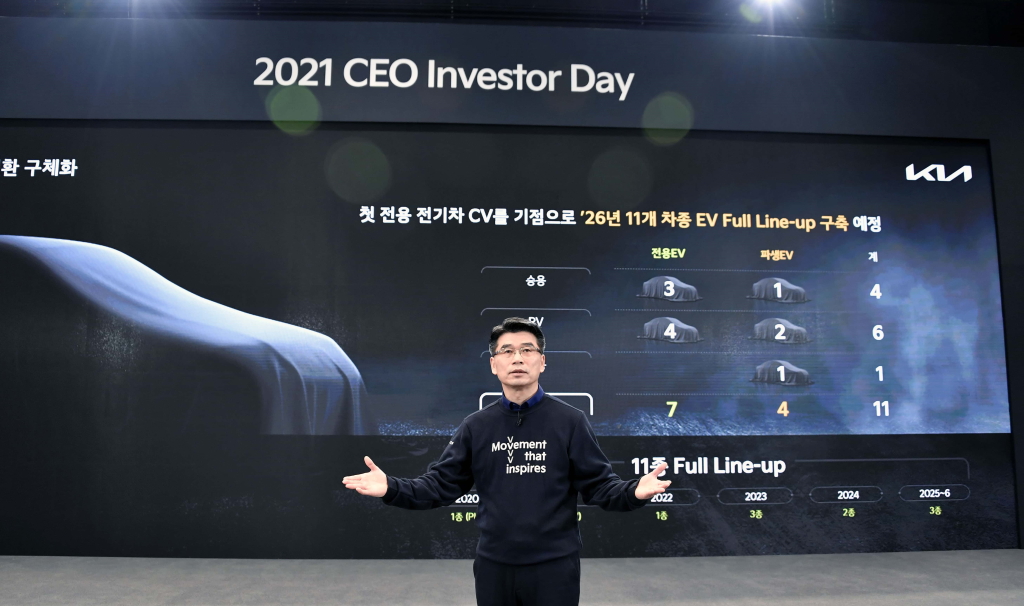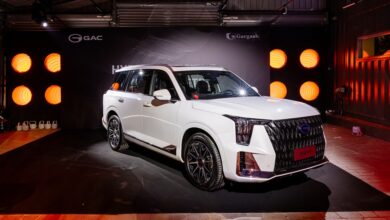- ‘Plan S’ updated with three core pillars: ·· Advancing EV transition – complete 11 model EV lineup with 7 dedicated
EVs by 2026; sell 1.6 mil eco-friendly vehicles annually by 2030
·· Strengthening PBV business – launch first PBV model in 2022; sell 1 mil
units annually by 2030
·· Expanding future mobility services – diversify services to meet customer
needs
- 2021 Business Plan – global sales 2.92 mil units; revenue KRW 65.6 tln; operating profit KRW 3.5 tln
- Mid- to long-term investment strategy – invest KRW 29 tln until 2025; maintain dividend payout at 25-30%

Kia announced an update to its ‘Plan S’ strategy for its future business at the 2021 CEO Investor Day, held digitally today in Seoul. The ambitious update to its mid- to long-term roadmap was presented by Ho Sung Song, President and CEO of Kia Corporation.
“Kia is being reborn in 2021 with a new logo, new design, and new corporate name,” said President Song. “Kia will transform into a brand that excites and inspires customers with innovative mobility experiences.”
‘Kia transformation’ takes the company toward a broader business portfolio to redefine the entire mobility ecosystem, starting with the transition from internal combustion engine (ICE) to electrification. The renewed ‘Plan S’ strategy is underpinned by three core pillars: advancing electric vehicle (EV) transition, strengthening purpose-built vehicle (PBV) business, and expanding future mobility services.

Advancing EV transition
By 2030, eco-friendly vehicles such as EVs, HEVs and PHEVs will make up 40 percent of all sales for Kia, with an annual sales target of 1.6 million units. As part of this, Kia aims to grow EV sales to 880,000 units in 2030 and become a top global seller.
Starting with the launch of its first dedicated EV later this year, Kia will strengthen its EV lineup by 2026 with 11 new models – seven dedicated EVs built on the Electric-Global Modular Platform (E-GMP) architecture, and 4 based on existing ICE derivatives.
EVs built on E-GMP aim to set new benchmarks in All-Electric Range (AER), driving performance, interior space, and tech application. The EVs will function as smart devices with expanded application of Audio Video Navigation Telematics (AVNT), Over-the-Air (OTA) and Feature on Demand (FoD) services.
The first dedicated EV from Kia, codenamed CV, will be featured with HDA2 (Highway Driving Assist Level 2) technology. Starting in 2023, Kia EVs will be equipped with Highway Driving Pilot (HDP), a crucial autonomous driving Level 3 development.
Further product details and performance specifications for the CV will be revealed next month.

Strengthening PBV business
Kia will unveil its first purpose-built vehicle (PBV) in 2022, with further PBVs to be launched according to market needs. The company is targeting annual sales of 1 million units by 2030 to become a world leader in PBVs. To this end, Kia will develop a variety of specialized vehicles based on its PBV-dedicated skateboard platforms.
Kia plans to further expand its PBV business through open innovation by cooperating with other companies to develop micro/large board platforms for unmanned delivery and e-commerce sectors. The company will also advance its own highly scalable small board platforms and technologies since the company expects market demand for these services to increase globally.
Expanding future mobility services
Kia’s mobility services will gain a competitive edge by carefully targeting and focusing on core areas.
In the business-to-consumer domain, Kia will expand existing services. In Spain, the company’s flagship car-sharing service Wible will be expanded with Wible Más and Wible Empresas (tentatively named). The car usership service ‘KiaMobility’, which was launched in September last year as a pilot project in Italy and Russia, will also launch in additional European markets.
In the business-to-government and business-to-business, Kia will launch an EV-based service that combines subscription and car-sharing. Under this new mobility service concept, vehicles will be used for business on weekdays and rented by individuals on the weekends.
Kia’s subscription program ‘Kia Flex’, which was introduced in Korea in 2019, will launch a global version later this year under the name ‘Kia Subscription.’ The service will be operated by Sixt Leasing, which was acquired by Hyundai Motor Group last year, and the vehicles will be provided by the company’s regional affiliates and dealers.
Future business plans
(1) Business targets
Kia forecasts operating profit growth this year, based on increased sales volume and improved Average Selling Price (ASP) and product mix. In summary:
2021 Global Sales (based on wholesale): 2,922,000 units, 12.1 percent increase Y/y
- 2021 Revenue: KRW 65.6 trillion, 10.8 percent increase Y/y
- 2021 Operating Profit: KRW 3.5 trillion, 70.1 percent increase Y/y
(2) Operating profit margin
With increased profitability for new EV models, Kia made upward adjustments to its operating profit margin targets from the figures initially announced last year. Kia now targets 5.4 percent operating profit margin in 2021, and 7,9 percent operating profit margin in 2025.
(3) Basis for the increase in operating profit margin
Balanced growth in both advanced and emerging markets
Kia plans to expand its mid- to long-term sales to 3.8 million units in 2025. The percentage of eco-friendly vehicle sales, which is expected to reach around 10 percent of total sales by 2021, is forecasted to increase to 22 percent by 2025. For emerging markets, the company will expand its market share through local CKD (complete knock-down) production.
Product mix improvement
Kia expects that the ASP and product mix improvement, which led to the company’s profitability enhancement last year, will continue. In particular, the company’s RV (recreational vehicle) sales share is expected to continue to rise from 56 percent in 2020 to 65 percent in 2025.
Improving profitability of electric vehicles
It is expected that Kia will enter a new level of EV profitability with the release of CV later this year. The company expects to achieve profitability at the level of existing ICE models in 2025. The company also predicts that EV cost improvement will be continuously strengthened through economies of scale due to the expansion of EV volume and the reduction of material cost through R&D investment.
Stable and steady investment plan
Kia’s investment outlay from 2020 to 2025 is expected to be KRW 29 trillion. Kia will maintain the annual investment level of around KRW 5 trillion, reducing the current investment in existing traditional business segments while gradually increasing the proportion of strategic investment for future projects. Furthermore, the company will expand its investment in R&D.





